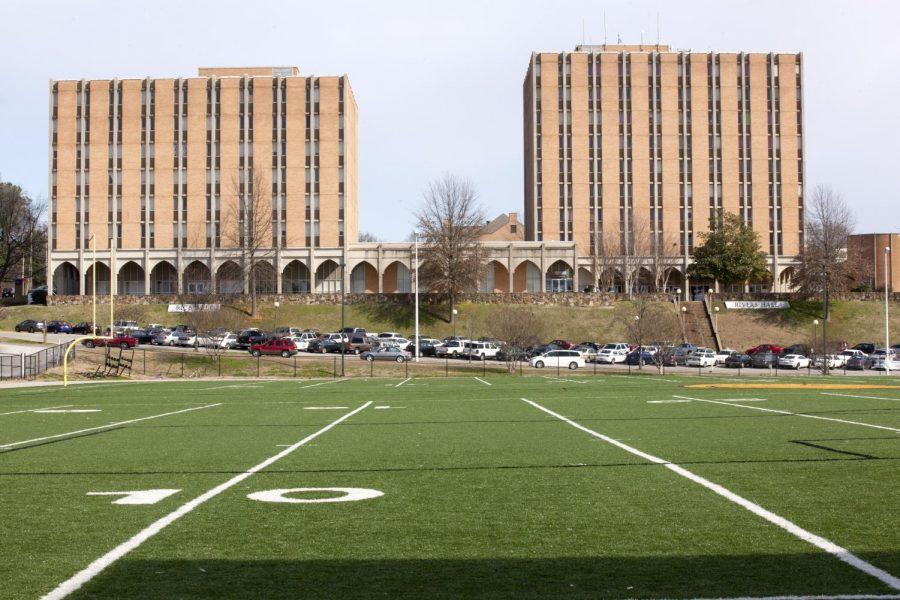Out with the Old, in with the New
September 19, 2013
Students will possibly see changes in on-campus housing starting as early as August 2015, after the UNA Board of Trustees approved a request to move forward with plans for the new North Campus Residential Village at their quarterly meeting on Monday, Sept. 16.
“While there are no formal contracts to present to the board today, we do want to move forward with this project under a Development Agreement,” said UNA President William Cale. “I just want the support of the board before doing so.”
University officials began looking into the possibility of new housing construction last year, said Vice President for Student Affairs David Shields. Five companies submitted a request for proposal, and after narrowing it down to two companies, both made presentations to a committee at the university, Shields said.
Capstone Development Partners LLC was chosen to begin the development process, Shields said.
“We as a campus selected this company,” he said.
Representatives from Capstone were present at the work session of the board meeting to give a presentation on their four-phase proposal for residential housing.
“We were here in 2010, and at the time, we said ‘Don’t build right now. You’re not ready,’” said Doug Brown, president of On-Campus Management with Capstone. “It’s remarkable, the progress that you’ve made since then. You’re certainly ready to build now.”
Jeff Jones, a principle owner of Capstone, introduced the four-phase plan that the university would be working on over the next five to 10 years. B.L. Harbert, a Birmingham-based construction company, will be in charge of construction, he said. The same company is currently building the new Science and Technology Building.
“This plan will allow for the phasing in of new housing to eventually replace the current housing,” he said.
Overall, the four phases and new residential halls would yield an estimated 1,700 to 1,850 housing spots in both single and double-occupancy rooms. The new halls would replace the existing residence halls, such as Rice, Rivers and LaGrange Halls.
Phase one of the proposal, which is expected to be finished and ready for occupancy by August 2015, would bring 700 to 750 first-year student housing slots. Of those slots, approximately 84 percent are expected to be double-occupancy rooms, Jones said. Rice and Rivers Halls would then be left for mostly single-occupancy upperclassmen housing, he said.
The preliminary development budget for Phase I of the North Campus Residential Village is set at $25,525,000, and, after completed, the residence halls would yield the university approximately $2,185,000 in net operating income, Jones said.
The university has two options for ownership of the residential housing — private or non-profit ownership. Regardless, ownership of the housing will completely transfer to UNA at the expiration of the 40-year ground lease term. By the end of that 40-year term, the anticipated operating net surplus for the entire residential village is approximately $14,425,000, Jones said.
The price tag for living in one of the new residence halls will be more than the rates for the current residence halls, but will be comparable to those of the newer facilities, such as Hawthorne, Covington and Appleby Halls, Shields said.
“We’ve looked at other prices for schools in Alabama, as well as schools in the Ohio Valley Conference,” he said. “We’re trying to find the best number we can. We want to provide the feel of a private university at a public-university cost.”
The construction of these new residence halls is part of the university’s plan to maximize the first-year experience, Shields said.
“The first year is really about community and connection,” Jones said, agreeing with Shields. “Our company has a wealth of experience working with universities over time. Hopefully your university can benefit from this.”
The board also unanimously approved the university’s proposed budget for the 2013-2014 fiscal year, which begins on Oct. 1. A cost-of-living raise was not afforded this year, as a major cost increase for the fiscal year is the teacher retirement match, Cale said. The rates went up from 10.08 percent to 11.71 percent, which is approximately $600,000, according to the proposed resolution summary.











